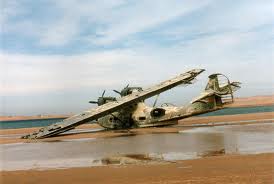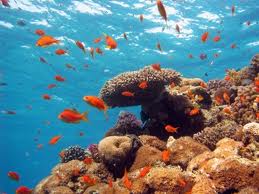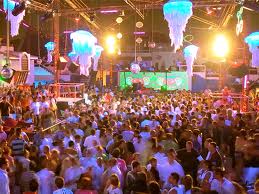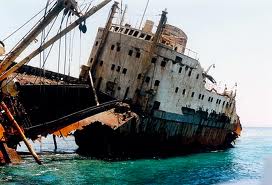
![]()
Index • |
Welcome • |
About
Us • |
21st Century • The Future |
World
Travel • Destinations |
Reviews • Books & Film |
Dreamscapes • Original Fiction |
Opinion
& Lifestyle • Politics & Living |
Film
Space • Movies in depth |
Kid's
Books • Reviews & stories |
Dreamscapes Two • More Original Fiction |
The International Writers Magazine: A historical note
Borrowed geography can cause trouble
• Saleem Ayoub Quna
As I was packing for my vacation in Sharm Al-Sheikh, one item on my must-do list was clearly underlined; See the straits of Tiran at the mouth of the Gulf of Aqaba. The rest of errands could wait.
In the mid 1960s and while I was physically and emotionally maturing, I had heard so much about these straits in the media. The more I heard about them, the more they became mysterious, exotic and legendary in my psyche. In the following years, I came to the conclusion that these straits played a decisive role not only in reshaping the geopolitical map of the whole Middle East region, probably for ever, but also helped shape my own personal destiny as well.
As I watched the bigger island (Tiran) from the medium size tourist boat at 1km distance, I had the notion that these straits must have been that kind of a natural time-bomb that was waiting to explode when the right moment arrived. That moment arrived in May 1967 when the former Egyptian President Jamal Abdul-Nasser blockaded those straits in face of ships heading to or coming out from the Israeli port of "Eilat", the only Israeli sea link to the Red Sea and the Indian Ocean. In reality these straits are Saudi territory, but for reasons I am not aware of, they were "leased" or "borrowed" to Egypt for an indefinite period!
But last week when I, along 20 other passengers, boarded the boat at shore of Na'ama Bay, our guide told us to my dismay that we could not land on those islands. No one could. Later, I learned that the two islands were carpet land-mined by the Israelis when they evacuated them in 1982 in compliance with the peace treaty they signed with Egypt.
32 years separate us now from that historical turning point in June 1967. My 4 days visit to Sharm Al-Sheikh provided me with a fresh perspective at how idle geography represented by two small islands (Tiran island 80 sq km and Sanafir island sq 33 km) sitting at the mouth of the Gulf of Aqaba could cause major and lasting regional and international changes with repercussions affecting the daily lives of average citizens, like me, in this region. Wars can erupt over big and complicated issues, but pretexts for war can come in abundance.
Nevertheless, this present account is not meant to be about the political or historical lessons I have learned from the June 1967 war, or how best a strategically located straits could have been used, for I am neither a military nor a politician. I am just a man of observation with a notebook in hand.The one day cruise
The previous day, I had signed up for the one day cruise at a small kiosk in one of the many alleys cutting through the two main pedestrian streets in Na'ama Bay. The kiosk had offers for camping in the desert, four-wheel motor cycling, a trip to Santa Catherine monastery in the middle of Sinai and even excursions to Aqaba and Petra in Jordan. The attendant at the kiosk asked me some questions; where are you from, which hotel you are staying at and are you alone or with friends. Then his boss looked at me in the face and said: "Ok, it is 120 Egyptian Pounds". Then he handed me a receipt. The trip would start at 9 am and end at 4 am. It would include soft drinks, lunch prepared on board and three stops in the sea where divers would be able to enjoy the beauty of the marine life and coral reefs. Unprepared divers or swimmers like me could watch from the deck, and that was less fun than the actual diving! Diving and snorkeling equipment were available for rent at shore.Sharm Al-Sheikh: a success story
But before I go on recounting the events of this one day cruise these are my notes on the city of Sharm Al-Sheikh itself.
Before it became a world famous resort, Sharm al- Sheikh was a quiet small fishing village. But Egyptian planners work started bearing fruit in the late 1980s as they put together a comprehensive development plan for the whole area with Sharm Al-Sheikh as its center. International investors such as the big hotel chains and restaurants started franchising along the coast of the Sinai Peninsula on the east shore of the Sues canal, often referred to as the Egyptian Riviera, and on the west shore of the Gulf of Aqaba.
Sharm A-Sheikh town was divided into five centers: Nabq, Ras Nusrani, Na'ama Bay, Umm Sid and Sharm Al Maya. These centers are connected by good roads and all municipality services such as electricity and water. Special attention was paid to the environmental issues on land and in sea. An international airport lies at 20 minutes drive from center Na'ama Bay. Planes flew low over the city for landing day and night at an average pace of 10 to 15 minutes between each plane.
The city is designed in a way that would allow visitors to remain distracted during most of the 24 hours of the day. In the morning and up to the late afternoon tourists would be sunbathing, swimming, reading or playing cards along the sandy beaches. Some would go surfing or watching the coral reefs sitting in glass boats. Beach bars open early for business and all have happy-hour signs. If you sit for ten minutes at any spot along the promenade, at least 8 to 9 gazette vendors would stop near you offering papers and magazines in various international languages. As if you forgot your own nationality, the salesman would remind you that he has papers in English, French, Arabic, Italian and Russian.
But the real action starts in the evening especially at Na'ama Bay center. Here you can experience the traditional Egyptian night-life, where most of the 250 hotels are clustered along its winding beach. Hundreds of restaurants and coffee shops line up on both sides of the main promenade adjacent the beach and all other pedestrian crossroads within the town limits. Other shops and boutiques are saturated with clothes and products necessary for a beach holiday. There is not one single café or restaurant which would not offer the famous Shisha or hubbly-bubbly service. People of all ages would be sitting in the large comfortable couches covered with all kinds and colors of home-made fabrics puffing these hubbly-bubblies and watching the scores of people strolling along the wide promenade. The settings in these cafes are meant to remind the clients of the one thousand and one night tales. It is either the allure of this atmosphere or the secret of the heavy scented tobacco that make clients order the bubbling colorful glass long vase attached to a long winding pipe made of flexible plastic. The scent of this kind of tobacco cannot be missed all along these streets.
Popular Arab songs are transmitted through loudspeakers and the sounds of these songs seem to collide in the air that fills the space between the two sides of the street or the two neighboring cafes. This is only an example of how far these businesses are willing to go to attract wandering tourists. Each shop has at least one young man standing at the entrance of the business. He would boldly approach the passing by tourists and initiate a conversation with them on any topic starting from how are you, to where you come from to why do not you try our delicious dishes inside in as many as four or five international languages. The promotion man would even start explaining in detail the ingredients of certain meals. Some clients could be intimidated by this tactic and the bonus of course goes to the pushy talkative young man.
Long and winding strings of colorful bulbs of different sizes and shapes dangle over every angle of every shop or café. The thick dazzling and blinking lights are could make you feel like walking in a roofless tunnel made of electronic light walls. If you add to that the on going commotion in the street and the conflicting sounds of songs and music, you might be easily reminded that pollution can also go audiovisual!
Of course the one thousand and one night culture can not be complete without the famous Egyptian belly dancing. This feature is available at all night clubs that offer seated dinners. But many coaches are ready to offer belly dancing lessons during the day time in the open air at the beach. Women in swimming suits would be lining-up in rows imitating the movements of their female coach. This is done for two reasons: fitness and experience.Back to the boat
Before boarding the boat passengers' names were called and I discovered that there were about other ten boats anchored close-by to go on the same itinerary. Our white boat named the President (25 meters long and 6 meters wide) sailed into a relatively agitated sea that some times created splashes back to the top deck. The boat sailed at the speed of 20 km per hour which I thought was an additional element for relaxation.
The three stops
After nearly two hours of sailing, the boat slowed down and the guide with the name of Haytham, a bulky dark skinned young man in his late twenties explained:" Here we will stop for 45 minutes during which you can dive and swim".As the boat came to a semi complete stop, Haytham took off his clothes and jumped into the blue clear waters. First, I wondered why he was in such a hurry. Then I realized his job was to pull the rope released by his colleague on deck to attach it to a pole fixed under water and then another rope to another pole. This way the boat came to a complete stand still, except for the little ups and downs caused by the ever moving waves of the sea. Most of the twenty passengers including women in Moslem attire jumped into the water. Some of them did not use any diving equipment; they just swam around. From my vintage point I could see three colors of the sea water, clearly separated: green, white and blue. Underneath the water, there were different formations of coral reefs in size, altitude and color. I envied those who were down in the water. There are about 150 different coral reefs in that part of the Red Sea. Then one could sea many species of fish distinguishable by size and color. Here too the Red Sea is home for more than 1000 species of fish.
When the 45 minutes passed, the guide called upon the swimmers to climb back. We sailed for another half an hour and we came to another stop. This location had a larger lagoon and it was closer to the Tiran Island. Here I noticed two small war vessels positioned just between our boat and the mainland of the island.
At this stop other four tourist boats came close by and took anchor next to ours. A sailor from the next boat would throw a rope over from his boat to ours and his colleague would pick it up and tie it through a hole to a pole on the deck. In few minutes four of five boats would be anchored next to each other, while swimmers and divers from all the four or five boats enjoyed their adventure in the clear blue water. When time was up the sailors would untie the ropes and throw them back into the water so the boats would be set loose again. When the boats anchor so close to each other, one could see the other passengers on the other boats and see what they were eating or drinking. Sailors would exchange greetings, jokes and cigarettes and it seems as if they used a vocabulary of their own.
At the third scheduled stop on the trip, the crew started preparing lunch and the cooking steam reached all corners of the boat. It was a buffet lunch consisting of salads, typical Egyptian vegetable stew dishes with two large Shish Kebab plates and rice. Tea, coffee and other soda drinks were also served. Before that four Egyptian young passengers wrapped by their large towels, lined up behind a fifth friend on the deck to make the noon prayer. They were told by the captain about the right direction to the Ka'ba in Mecca.
After lunch it was siesta time under the warm rays of the sun and breeze. By this time the sea became calm and the boat sailed quietly back to the shore at the same speed. The sun was on our right now and it was slowly sinking behind the mountains of the Sinai while giving the skies above a reddish color. I was looking at Sharm Al Sheikh town and wondering how long it would take to reach it.Fun till the end
While at that thought, two unexpected things happened that created excitement and commotion on the boat: First, one sailor suddenly shouted:" Look, look. There are dolphins here". And every one jumped to their feet and there they were; a herd of dolphins jumping swiftly out of the water and diving back. Some were swimming so close to the boat as if they would collide with it. But the dolphins were quicker and possessed better maneuverability skills than our captain and his boat. This race went on for many precious enjoyable minutes and finally it seemed the dolphins decided to abandon the uneven race with our boat and receded back to the deep waters.
Sooner another tourist boat came so close to ours. A sailor from that boat called our captain and told him he had a problem with the engine. Without much fuss, sailors of our boat threw a rope to that boat and towed it for almost one hour. A passenger started complaining about the unexpected delay for he was worried he would miss a pre-arranged meeting with his clients. The captain put a good argument:" Law of the sea obliges us to help troubled boats," he said," What would you do if it was our boat which had a problem" he added. He later contacted the port police and reported the incident. A towing vessel soon appeared and took over the mission of towing.Last surprise
More Travel
Of course for every trip of this kind one must allocate a certain budget. I just did that and I was content with what I was offered so far by my agency in Amman. On the last day of my stay I met a British couple at the breakfast table at the hotel. I noticed they had yellow plastic bands around their wrests like many other guests. I asked them about those bands. They told me they serve like a password for "all inclusive" service at the hotel including three meals and all kinds of drinks. And how much that "all inclusive" have cost you, I asked them. "Less than 300 English Pounds each," they told me which also covered the round trip ticket from London plus full accommodation for seven days.
They laughed when I told them that I should have booked my vacation from London too. From Amman my agency offered me 3 nights and 4 days including breakfast, dinner and one soft drink with each meal, for almost the double amount the British couple paid.
Can some tourism experts who may read my story explain this to me?
© saleem quna April 2011
b2beinitiative@yahoo.com




